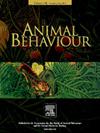Estimating social network metrics from single-file movements in Barbary macaques, Macaca sylvanus
IF 2.3
2区 生物学
Q2 BEHAVIORAL SCIENCES
引用次数: 0
Abstract
Traditional methods for quantifying animal social network structure, and especially global-structural measures such as community structure, require large amounts of high-resolution data, which can be time-consuming and labour-intensive to collect. In this study, we investigated the efficacy of using a recently proposed, less effort-intensive method for collecting social association data based on the observed order of individuals in single-file movements. We used this method to estimate the social network of a group of semi-free-ranging Barbary macaques, Macaca sylvanus and then applied the Louvain community detection algorithm to estimate the community structure within the group. We validated the results by comparing them to networks informed by data from more traditional sampling methods for social network analysis, namely scan sampling and focal observations. Using Mantel tests with Spearman correlations, we found statistically significant but weak positive associations between the community assignments and dyadic association indices derived from the single-file movement data and those from the scan and focal data. Our findings do not provide convincing evidence that association data obtained from only 20 observations of single-file movements can reliably be used to estimate the strength of dyadic relationships or the composition of discrete communities within the larger group. However, the results from the community detection algorithm converged to similar estimates for the modularity value and the number of communities present in the group, irrespective of the data collection method used. We suggest that data from observations of single-file movements may not be useful for estimating fine-grained social network structure but may offer researchers a ‘quick and dirty’ method for determining whether meaningful community structure exists within their study groups as part of a pilot study and an efficient method for wildlife managers and conservationists to monitor population-level disturbances to social structure.
从巴巴里猕猴的单文件运动中估计社会网络指标
量化动物社会网络结构的传统方法,特别是社区结构等全球结构措施,需要大量高分辨率数据,这些数据的收集既耗时又费力。在这项研究中,我们调查了使用最近提出的一种更省力的方法收集社会关联数据的有效性,该方法基于观察到的单个队列运动中个体的顺序。利用该方法对半散居猕猴Macaca sylvanus群体的社会网络进行了估计,并应用Louvain群落检测算法对群体内的群落结构进行了估计。我们通过将其与更传统的社会网络分析抽样方法(即扫描抽样和焦点观察)所提供的数据进行比较,验证了结果。使用Mantel检验和Spearman相关性,我们发现从单档案运动数据和扫描和焦点数据得出的群落分配和二元关联指数之间存在统计学上显著但微弱的正相关。我们的研究结果并没有提供令人信服的证据,证明仅从20个单队列运动观察中获得的关联数据可以可靠地用于估计大群体中二元关系的强度或离散社区的组成。然而,无论使用何种数据收集方法,社区检测算法的结果都收敛于对组中存在的模块化值和社区数量的类似估计。我们认为,单队列运动的观测数据可能对估计细粒度的社会网络结构没有帮助,但可能为研究人员提供一种“快速而肮脏”的方法,以确定在他们的研究小组中是否存在有意义的社区结构,作为试点研究的一部分,也是野生动物管理者和保护主义者监测种群水平对社会结构的干扰的有效方法。
本文章由计算机程序翻译,如有差异,请以英文原文为准。
求助全文
约1分钟内获得全文
求助全文
来源期刊

Animal Behaviour
生物-动物学
CiteScore
4.60
自引率
8.00%
发文量
236
审稿时长
10.2 weeks
期刊介绍:
Growing interest in behavioural biology and the international reputation of Animal Behaviour prompted an expansion to monthly publication in 1989. Animal Behaviour continues to be the journal of choice for biologists, ethologists, psychologists, physiologists, and veterinarians with an interest in the subject.
 求助内容:
求助内容: 应助结果提醒方式:
应助结果提醒方式:


